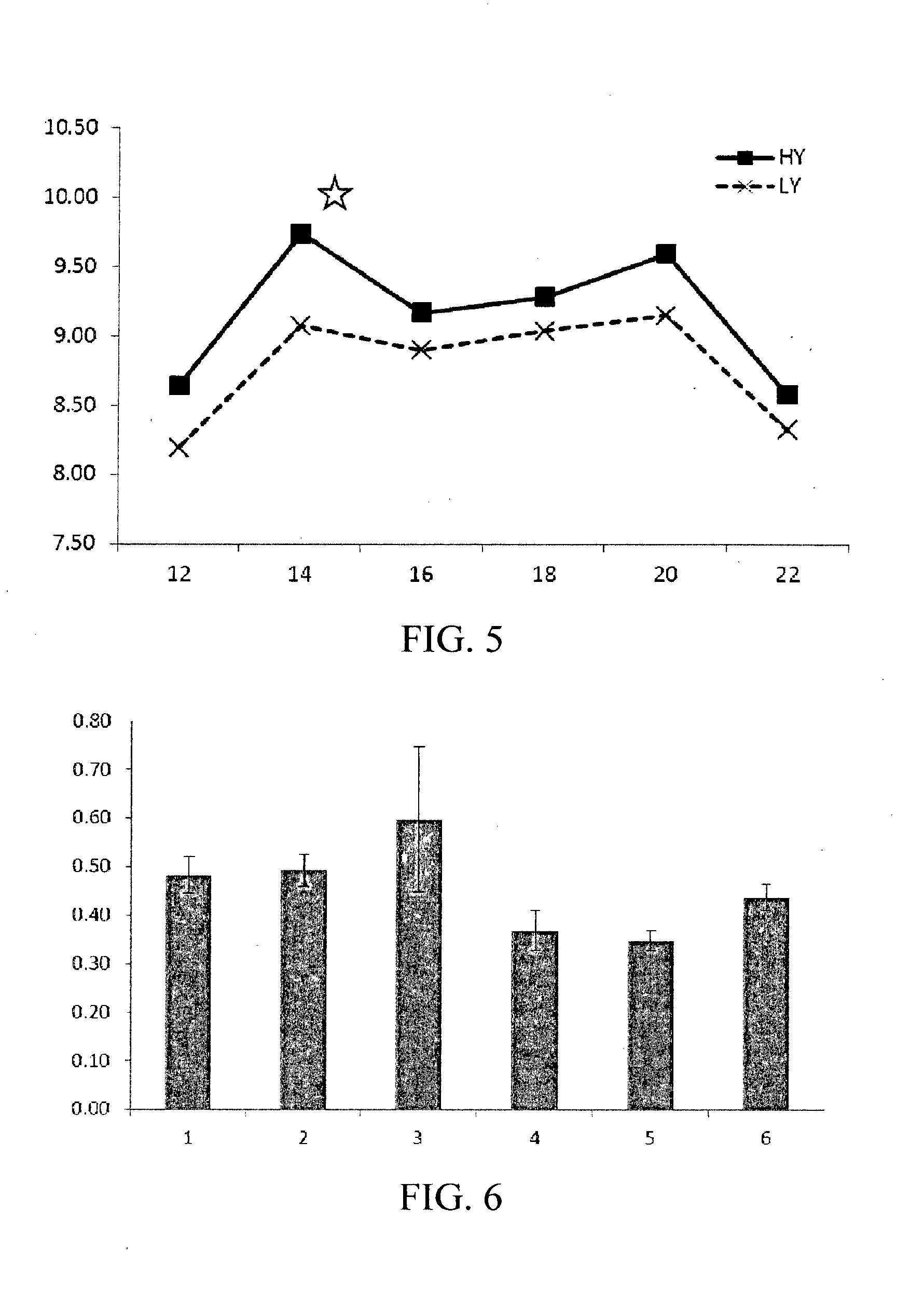Methods for obtaining a genetically modified plant or microbe and for increasing oil yield
a technology of genetically modified plants and microorganisms, applied in the direction of fatty-oil/fat production, carboxylic compound separation/purification, enzymes, etc., can solve the problems of time and labor, time and labor intensive conventional breeding techniques for propagation of oil palm for oil production, and inability to propagate thereof by direct hybrid crosses. , to achieve the effect of increasing oil yield, reducing the activity of triose-phosphate isomerase, and increasing the activity of phospha
- Summary
- Abstract
- Description
- Claims
- Application Information
AI Technical Summary
Benefits of technology
Problems solved by technology
Method used
Image
Examples
example 1
Defining High-Yielding Oil Palms and Low-Yielding Oil Palms
[0094]Two screening populations of oil palm plants, a high-yielding screening population (also termed HY) and a low-yielding screening population (also termed LY), were used. The screening populations were derived from crosses of Serdang Avenue dura (at least 75% of Serdang Avenue dura) and AVROS pisifera (at least 75% of AVROS pisifera) to yield tenera progeny. The high-yielding and low-yielding palms are defined by the quantity of oil produced by them in tonnes per hectare per year. In this study, an oil palm was considered high-yielding if it produced more than 10 tonnes of oil per hectare per year, and an oil palm was considered low-yielding if it produced less than 6 tonnes of oil per hectare per year. Both screening populations were derived from a Carey Island oil palm plantation. The yield determinations were based on historical oil yield data for each sample.
[0095]For the examples that follow, samples of mesocarp tis...
example 2
Arabidopsis Microarray Experiment
[0096]Arabidopsis One-Color Microarray-Based Gene Expression Analysis.
[0097]Samples of oil palm transcripts obtained from high-yielding palms and low yielding palms at 16 weeks after pollination were hybridized on 4×44K microarray formats. Procedures for the preparation, labeling of complex biological targets, and hybridization, washing, scanning, and feature extraction of Agilent's 60-mer oligonucleotide microarrays for gene expression analysis were adapted from “One-color microarray-based gene expression analysis version 6.0” by Agilent Technologies.
[0098]Results. The Arabidopsis microarray data showed triose-phosphate isomerase was down-regulated (>1.7 fold) in high-yielding palms compared to low-yielding palms at week 16 after pollination, with a p value of 0.02.
example 3
2-D DIGE Experiment
[0099]Preparation of Samples.
[0100]A modified protein extraction method published by He et al. (I) was used to isolate total mesocarp protein from oil palm fruitlets. Subsequently, the extracted protein samples were resuspended in 2-D cell lysis buffer (30 mM Tris-HCl, pH 8.8, containing 7 M urea, 2 M thiourea and 4% CHAPS). The mixture was sonicated at 4° C., followed by shaking for 30 minutes at room temperature. The samples were then centrifuged for 30 minutes at 14,000 rpm and the resulting supernatant was collected. Protein concentration of the supernatant fraction was measured using Bio-Rad protein assay method (Bradford, 1976). To aid downstream analysis, an internal standard (IS) was prepared, by mixing equal amount of protein from each sample, and included in the 2D-DIGE experiment.
[0101]CyDye Labeling.
[0102]For each sample, 30 μg of protein was mixed with 1.0 μl of diluted CyDye, and kept in dark on ice for 30 minute. Samples from each pair of high-yield...
PUM
| Property | Measurement | Unit |
|---|---|---|
| Fraction | aaaaa | aaaaa |
Abstract
Description
Claims
Application Information
 Login to View More
Login to View More - R&D
- Intellectual Property
- Life Sciences
- Materials
- Tech Scout
- Unparalleled Data Quality
- Higher Quality Content
- 60% Fewer Hallucinations
Browse by: Latest US Patents, China's latest patents, Technical Efficacy Thesaurus, Application Domain, Technology Topic, Popular Technical Reports.
© 2025 PatSnap. All rights reserved.Legal|Privacy policy|Modern Slavery Act Transparency Statement|Sitemap|About US| Contact US: help@patsnap.com



